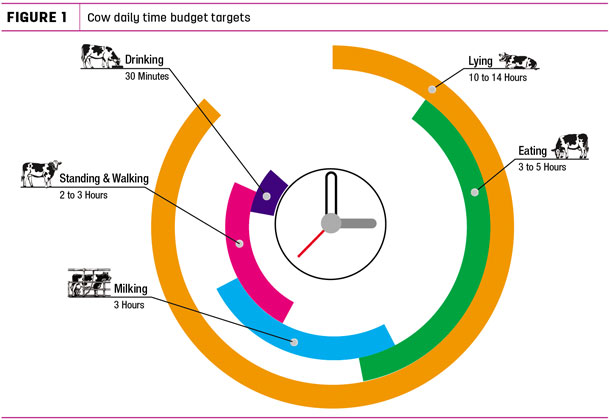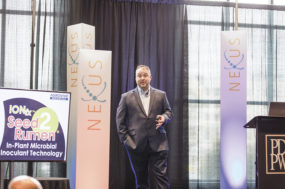There is “tremendous marginal value in getting cows to eat more,” Albert De Vries, department of animal sciences, University of Florida, said during the 2017 Cornell Cow Comfort Conference, hosted by Cornell Cooperative Extension North Country Regional Ag Team.
In order to eat more, cows need enough space for comfort, including reliable access to the feedbunk. In six-row barns, feedbunk space is the limiting factor more than in four-row barns, he said. Either way, finding the right stocking density to maximize your return on investment (ROI) is the goal.
“The response to overstocking would be much greater than the literature seems to suggest,” if there was a simple linear response to stocking density and milk production, De Vries said. “The simple math of how much milk do I lose ... it becomes a little bit more complicated.”
When cows can’t meet the needs of their time budget, welfare declines. Three to five hours of eating, 10 to 14 hours of lying time, two to three hours standing and walking, 30 minutes for drinking, and about three hours for milking are the targets (Figure 1).

Many responses can be impacted when overstocking causes cow comfort to decrease. Conception rates drop, feed intake decreases, milk production declines, increases in the injury rate occur, and lying times are negatively impacted.
At some point, any increase in overall milk production from adding more cows will be outweighed by these changes, and a negative ROI will occur.
Overstocking and profitability
Getting the best ROI from your facilities can mean adding more cows. As more cows are added, the per-cow cost of the facility decreases. But each added cow also decreases the profit from every other cow already there, to some degree.
Crowding a pen means “the performance of all cows in the pen is diminished a little bit,” De Vries said.
When overstocking, milk production loss per cow can be a significant factor impacting ROI, while reproductive changes will be a minor factor. Conception rates will decline slowly as stocking densities are increased. Milk production will decline per cow per day.
The milk price will play a role in how much overstocking will still be profitable. If the milk yield loss from overcrowding is small, then overstocking may not negatively impact the profit per stall per year. The milk loss per cow per day may still be compensated by adding more cows, keeping the ROI high. Profit can be calculated on a dollars per stall per year basis.
“Milk price will have a major effect on optimal stocking density,” De Vries said. “The limiting factor is barn size.” The amount of milk yield loss that can be incurred while still maintaining some profit will change as a function of milk price. Spreadsheets to help producers “play with prices” and determine profitability are available from the Florida Dairy Extension website.
When weighing the cost of building new to that of overstocking, producers need to take into account the reduction in profit overstocking can have. The cost of building a new facility, along with the net benefit received by recapturing any milk decline seen with overstocking the old facility, must also be considered.
When compared on a dollars per cow per year basis, the decision whether or not to build new, rather than overstock, can be simplified.
Economics of cooling cows
Heat stress is a major factor impacting milk production. In Florida, there is a big seasonal change in milk production, with a large spring surplus going to cheese production and a decrease in milk as the days get hot. But when cows are kept cool, that production drop during the hot weather decreases significantly.
Cooling dry cows has been shown to increase milk production by 11 pounds per day, and this change “is consistent through the next lactation,” De Vries said. “Milk is not made if dry cows are not being cooled. Are we really not cooling dry cows?”
In the western U.S., almost 50 percent of dairies do cool dry cows. In the East, it is under 8 percent. New York producers were calculated to have lost $112 per cow per year in the next lactation when dry cows were not cooled. This includes the value of lost milk, plus other economic losses.
There are both fixed and variable costs associated with dry cow cooling. Fixed costs occur regardless of heat stress, while the variable ones are due to the cost of running the fans, soakers and other technology used to keep things cool. The breakeven point changes with the number of heat stress days, the milk price and the overall milk production loss during periods of heat stress.
“It pays to invest in cooling, including building a barn,” for producers who have between 40 to 100 heat stress days per year, De Vries said. “It’s basically profitable to cool dry cows anywhere except Alaska.”
Cooling dry cows is very profitable if a new building is not required but is also profitable if building has to occur. New York averages about 80 days per year of heat stress conditions. For most producers, the ROI from investing in cooling dry cows will be less than one year, but it won’t occur until the next lactation, he said.
The impact of heat stress on calf growth is not reflected in the data. The lifetime impact of calves exposed to heat stress is a loss of about 10 pounds of milk per day, he said. The lifetime loss of milk yield from dry cows and calves exposed to heat stress is significant.
Cooling dry cows and keeping per-stall profit high can significantly enhance profitability. Investing in a new building to avoid overstocking concerns or to provide better cooling can pay off in many instances.
While some overstocking can be profitable, and the milk in the bulk tank may increase or remain stable when overstocking is minor, the loss of milk that occurs on a per-cow, per-day basis can be significant. Profit calculations based on the most limiting factor – the number of stalls – can help determine when the ROI in overstocked situations is problematic.
The income over feed cost ratio can also be used to guide overstocking, although it may seem counterintuitive, De Vries said. When the income over feed cost ratio is low, do not overstock. When it is high, overstocking can be profitable. ![]()
PHOTO: Cow comfort investments like cooling dry cows have a clear-cut benefit to a dairy’s bottom line. The impacts of overstocking, however, can be a moving target based on milk price. Photo by Mike Dixon.
Tamara Scully, a freelance writer based in northwestern New Jersey, specializes in agricultural and food system topics.





